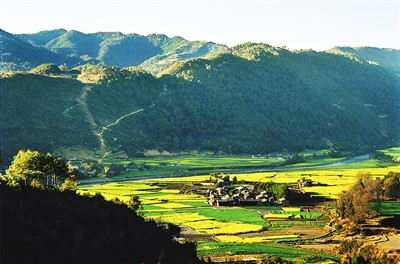Gaoligong Mountains: a living museum dedicated to biodiversity conservation
Gaoligong Mountains, which runs from southwest China's Qinghai-Tibet Plateau all the way to the Indochina Peninsula, have seen much effort in recent years dedicated to protecting its biodiversity protection.

Photo shows a glimpse of Gaoligong Mountains. (Photo/Du Xiaohong)
Back in 1918, after George Forrest, a Scottish botanist, first discovered a new species named rhododendron protistum var. giganteum (at 20m in length) and transported the specimens back to the UK, Chinese researchers spent more than 70 years searching for another plant of this variety.
"As a Goligong native, we cannot accept the fact that the only specimens of this variety of rhododendron were transported abroad and we could never lay eyes again on this species," said Duan Shaozhong, an official with the Gaoligong Mountains National Nature Reserve (GNNR). With this in mind, Chinese botanist Feng Guomei finally came upon more than 40 rhododendrons of this variety in 1982.
In an attempt to save the species, artificial breeding programmes were launched by relevant institutions. Statistics indicated that over 60 percent of the first seedlings of the variety survived, reflecting notable achievements in widespread species protection.
Similar breeding techniques were later applied in the conservation of another endemic rare and endangered plant called fosbergia shweliensis, which has been reintroduced back into the wild through similar efforts.

Photo shows a village at the foot of Gaoligong Mountains. (Photo/Ai Huaisen)
Another typical example showcasing local conservation efforts can be found in the case of the hoolock gibbon, native to this region and critically endangered.
In a bid to boost hoolock gibbons' reproduction, the local government established a "biological corridor" for them. Surprisingly, the move also helped spur populations of phayre's leaf monkeys, listed as endangered on the International Union for Conservation of Nature (IUCN) Red List, with their total population rising from 130 to around 300.
This increasing diversity, in turn, has positively contributed to ecosystem stability and the locals’ life satisfaction.
Instead of struggling in the past, locals have thickened their pockets by engaging in biodiversity protection activities. "We now have not only protected the ecological environment, but also enjoy a stable income," explained Zhang Min with a smile, who serves as a local forest ranger.
Photos
Related Stories
- Interview: China takes lead in supporting developing countries to combat climate change, protect biodiversity -- expert
- Seed bank provides a safe home for wildlife species
- Ecological Civilization Forum of COP15 opens in Kunming
- SW China's Jiaozi Mountain: home to rare animals, plants
- Tibet protects natural areas, improves biodiversity
- Interview: China makes powerful, inspiring commitments to biodiversity conservation at COP15, says WWF Int'l chief
Copyright © 2021 People's Daily Online. All Rights Reserved.










